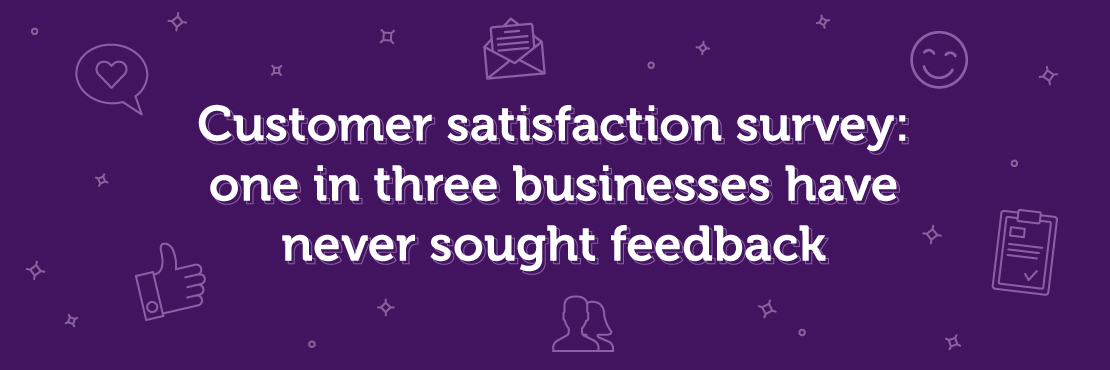
New research from Esendex suggests many businesses invest zero time into asking their customer base what they actually think of their products or services, meaning they could be missing out on critical information to keep their client base happy as well the potential growth opportunities feedback presents.
New research from Esendex suggests many businesses invest zero time into asking their customer base what they actually think of their products or services, meaning they could be missing out on critical information to keep their client base happy as well the potential growth opportunities feedback presents.
For many industries, customer feedback is an extremely important element, allowing brands and businesses to respond to consumer demands, market trends and update products and services accordingly to ensure they’re not left behind by competitors and, most importantly, ensure customers are satisfied. There’s a reason why TripAdvisor is one of the most visited websites globally today.
How often do businesses collect customer feedback?
Based on our survey of hundreds of international businesses, more than a third of respondents suggested they had never asked customers for feedback in the form of a customer service survey.
Retailers were least likely to request feedback out of all of the industries featured in this research, with some interesting universal findings across the retail, finance and utilities sectors:
- Almost 40% of respondents said they never send out customer service feedback surveys
- A further 7% said the last time they sent out a customer service feedback survey was more than five years ago
- One in three (35%) said they had sent a survey in the last three months
- 32% said their company’s customer service levels are either ‘fair’ or ‘poor’
- One in five businesses (20%) said they have never invested in enhancing their customer satisfaction levels through either processes or tools with a further 9% saying the last time they did this was over five years ago
- Just 37% said they have invested in customer feedback over the last three months
Where did retailers stack up on customer feedback?
When looking at the last three months specifically, retailers were found to actually be one of the most likely to send out a customer service feedback survey, with 31% of respondents suggesting they had done so. However, it is also the industry where the highest proportion of businesses surveyed admitted they had never sent one as all.
- The majority of retailers said they are ‘very good’ or ‘good’ at measuring and benchmarking customer satisfaction (over 70% combined)
- While most said their customer service levels were ‘very good’ or ‘good’ right now (over 70%), that’s still almost one-third of retailers that said they were ‘fair’ or ‘poor’
- Less than half of retailers (45%) claimed they had invested in enhancing their customer satisfaction levels within the last three months
- More than a quarter of retailers said it’s been at least five years since they last time they invested, or they never have
A fifth of financial businesses rated their customer service levels as ‘fair’ or ‘poor’
When looking across all industries featured in the research, 20% of finance businesses admitted to never sending out customer service feedback surveys. In addition, a fifth of finance firms rate their own level of customer service as fair or worse. Other notable findings include:
- Just 42% said they had sent a survey within the last three months
- When asked about investing-specifically, less than half (44%) of finance companies have invested in customer service feedback in the last three months, with a quarter of those surveyed having invested over five years ago, or never
More than a quarter of utilities firms haven’t requested feedback in more than five years
Looking at utility companies specifically, the most startling stat we discovered in the research was that 28% of firms haven’t asked their customers for feedback for at least five years, or have never done so.
In an industry where switching providers is now easier than ever, this suggests that many brands are playing a potentially dangerous game. Some of the other findings include:
- Just one in three businesses said they have sent a customer service feedback survey in the last three months
- When describing how good their business was at benchmarking customer service levels, the utility sector was least likely to answer ‘very good’ (5%) with 13% acknowledging it was ‘fair’ or ‘poor’
- Similarly, for Q4, most companies (80%) said they feel their customer service levels are ‘very good’ or ‘good’
- 38% had invested in their customer satisfaction levels in the last three months
Why are customer feedback surveys so important?
There’s never been a more pressing time for businesses to be striving for customer service excellence and to be communicating with and seeking feedback from those already engaging with their products or services.
Surveys are one of the easiest ways to gain valuable insights from those that buy from you and can help to build a loyal customer base. While some may worry they will not get a good response rate, it’s surprising how many people are willing to give a couple of minutes of their time to provide their honest opinions.
With a plethora of communication platforms available to businesses these days, you can easily test what works best for you – whether that’s seeking feedback through social media, email or sending an SMS message straight to your customers’ phones, which has a 95% open rate.
How to run an effective customer feedback survey
- Respect your customers’ time
Try to be succinct when running a survey, asking no more than a handful of questions. Customers may be happy to spare a couple of minutes of their time, but you lose them the moment they feel it’s taking too long. Even better, be upfront with customers about how long a survey might take before they start answering the questions, so they know what to expect.
- Use different types of questions
To keep customers engaged, it’s always best to aim for a mix of quantitative and qualitative data. One or two open-ended questions is always a good idea because customers may tell you something you hadn’t thought of before. Equally, having a question where people can rate your customer service on a scale of one to ten can help you to see how you’re improving over time.
- Remain neutral for better results
It may be tempting to ask questions that give you the answer you want, but you aren’t giving customers the chance to show their true feelings by skewing the questions. Negative feedback is never nice to receive but it can provide some powerful insights and highlight any areas for concern.



